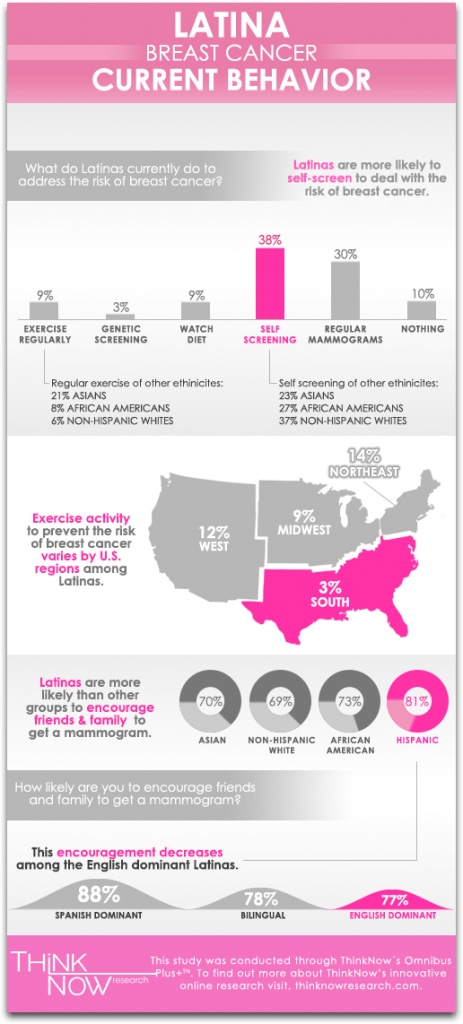Latina Breast Cancer – Key Differences in Current Behavior
A few weeks ago we released some research on Latina awareness of issues surrounding breast cancer as part of our commitment to the Passionate Pursuit of Prevention campaign being undertaken by Healthy Hispanic Living and its partners. We found that, overall, Latinas are less concerned about getting breast cancer than their non-Hispanic white cohorts. Other issues such as diabetes, heart disease and high blood pressure were more top-of-mind for them than the risk of getting breast cancer.
We wanted to see if these lower levels of concern among Latinas also translated into fewer preventative behaviors and found some significant differences between Latinas and other ethnic groups as well as among different segments within the Latina community. Here's an infographic showing key information we discovered...
Based on a nationally representative survey of 775 Latina, non-Hispanic white, African American and Asian women we’ve discovered that 38% of Latinas currently list self-screening as one of the things they do to address the risk of breast cancer which is about the same as non-Hispanic whites but considerably higher than African American (27%) and Asian (23%) women who list self-screening as something they currently do. Exercise was mentioned by 9% of Latinas nationally but only 3% of Latinas who live in the South. 23% of Asian women, however, listed exercise as something they do to address the risk of breast cancer.
Another interesting finding was that the percentage of Latinas that had a mammogram within the past 12 months (34%) is in line with other ethnic groups but that this percentage changed considerably based on income. The likelihood to have had a mammogram within the last year increased by 25% for Latinas who were over age 50 if they were in households earning $40K a year or more. Younger Latinas had an even greater likelihood of having had a mammogram in the past year if they had higher income. Differences in this metric were even more pronounced when looking at Latinas from households earning $70K or more. The income disparity in getting mammograms may be partially explained by lower levels of health insurance coverage among lower income Latinas though the ACA is helping close that gap. Another explanation may be that lower income Latinas have less free time and more difficult commuting options when it comes to scheduling and keeping appointments for mammograms.
Finally, we wanted to see if there was a difference between Latinas and other ethnic groups in their willingness to encourage friends and family members to get a mammogram. 81% of Latinas said they were likely to encourage others to get mammograms vs. 69% of whites, 73% of African Americans and 70% of Asians who said they would do the same. This speaks to the strong social networks U.S. Hispanics enjoy and their willingness to take a personal interest in the wellbeing of their friends and family. That cultural difference, interestingly, is being driven by Spanish Dominant Latinas since 88% of them reported that they would encourage friends and families to get a mammogram whereas 78% of Bilingual and 77% of English dominant Latinas said they would do the same.
We’ll be looking at these acculturation driven differences in our next installment of this research where we’ll be exploring reasons Latinas give for having or not having mammograms. Hopefully, through understanding these reasons and motivations we’ll be able to affect change that encourages more Latinas to take positive action towards improving their own health as well as the health of their friends and loved ones.
This blog post was originally published on Healthy Hispanic Living, where you can view other information encouraging a healthy lifestyle for the U.S. Hispanic Community.
To find out how we can help you gain insights on health matters and other topics, please feel free to contact us.
